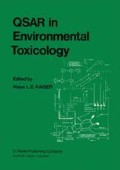Abstract
The internal rotational barriers of PCB isomers were computed using the quantum mechanical INDO method and corrected for the known deficiencies of this semi—empirical model. Based on the hypothesis that the active molecule must be planar, a correlation coefficient (r2) equal to 0.98 was found between the arylhydrocarbon hydroxylase activation data and the fraction of planar conformers predicted from a Boltzmann like distribution.
Access this chapter
Tax calculation will be finalised at checkout
Purchases are for personal use only
Preview
Unable to display preview. Download preview PDF.
References
Allinger, N.L and Sprague, J.T. 1973. Calculation of the structures of hydrocarbons containing delocalized electronic systems by the molecular mechanics method. J. Am. Chem. Soc. 95: 3893–3907
Almlöf, J. 1974. Ab initio calculations on the equilibrium geometry and rotation barriers in biphenyl. Chem. Phys. 6: 135–139
Bartell, L.S. 1960. The effects of intramolecular van der Waals forces. J. Chem. Phys. 32: 827–831
Birner, P. and Hofmann, H.J. 1982. Quantum chemical calculations for the determination of the molecular structure of conjugated compounds. Part XVII. Int. J. Quantum Chem. 21: 833–843
Born, M. and Oppenheimer, J.R. 1927. Quantum theory of the molecules. Ann. Physik. 84: 457–484
Bott, G., Field, L.D. and Sternhell, S. 1980. Steric effects. A study of a rationally designed system. J. Am. Chem. Soc. 102: 5618–5626
Casalone, G.L., Mariani, C., Mugnoli, A. and Simonetta, M. 1968. Molecular structure of biphenyl in the gas and solid phases. Mol. Phys. 15: 399–348
Field, L.D. and Sternhell, S. 1981. The conformation of biphenyls in nematic liquid crystalline solution. The relationship between the torsional angles and the size of the halogens in 2, 6-dihalogenated derivatives. J. Am. Chem. Soc. 103: 738
Field, L.D. Sternhell, S. and Tracey, A.S. 1977. The conformation of biphenyls in nematic liquid crystalline solution. An investigation of the torsional angles in 2,6-dihalogenated derivatives. J. Am. Chem. Soc. 99: 5249–5253
Fischer-Hjalmars, I. 1963. Conjugation and non—bonded interaction. Tetrahedron 19: 1805–1815
Goldstein, J.A. 1979. The structure—activity relationahips of halogenated biphenyls as enzyme inducers. Ann. N.Y. Acad. Sci. 320: 164
Goldstein, J.A. Hickman, P., Bergman, H., McKinney, J.D. and Walker, M.P. 1977. Separation of pure polychlorinated biphenyl isomers into two types of inducers on the basis of induction of cytochrome P-450 or P-448. Chem.-Biol. Interact 17: 69–87
Goldstein, J.A., Hass, J.R., Linko, P. and Harvan, D.J. 1978. 2,3,7,8-Tetrachlorodibenzofuran in a commercially available 99% pure polychlorinated biphenyl isomer identified as the inducer of hepatic cytochrome P-448 and arylhydrocarbon hydroxylase in the rat. Drug Me tab. Mspos. 6: 258–264
Gropen, O. and Seip, H.M. 1971. Failure of the CNDO/2 method to predict the barriers and conformations in some conjugated systems. Chem. Phys. Lett. 11: 445–449
Kaiser, K.L.E. 1974. On the optical activity of polychorinated biphenyls. Environ. Pollut. 7: 93–101
Pariser, R. and Parr, R.G. 1953. A semiempirical theory of the electronic spectra and electronic structure of complex unsaturated molecules. II. J. Chem Phys. 21: 767–776
Parkinson, A., Cockerline, R. and Safe, S. 1980a. Polychlorinated biphenyl isomers and congeners as inducers of both 3-methylcholanthrene- and phenobarbitone-type microsomal enzyme activity. Chem. Biol. Interact 29: 277–289
Parkinson, A., Robertson, L.W., Safe, L. and Safe, S. 1980b. Polychlorinated biphenyls as inducers of hepatic microsomal enzymes: Structure-activity rules. Chem. -Biol. Interact 30: 271–285
Parkinson, A. and Safe, S. 1981. Arylhydrocarbon hydroxylase induction and its relationship to the toxicity of halogenated arylhydrocarbons. Toxicol. Environ. Chem. 4: 1–45
Parkinson, A., Robertson, L.W., Safe, L. and Safe, S. 1981. Polychlorinated biphenyls as inducers of hepatic microsomal enzymes: Effects of di-ortho substitution. Chem.-Biol. Interact 35: 1–12
Poland, A. and Glover, E. 1973. Chlorinated dibenzo-p-dioxins. Potent inducers of δ-aminolevulinic acid synthetase and arylhydrocarbon hydroxylase. Structure-activity relation. Mol. Pharmacol. 9: 736–747
Poland, A. and Glover, E. 1977. Chlorinated biphenyl induction of arylhydrocarbon hydroxylase activity: A study of the structure-activity relationship. Mol. Pharmacol. 13: 924–938
Poland, A., Glover, E. and Kende, A.S. 1976. Stereospecific, high affinity binding of 2,3,7,8-Tetrachlorodibenzo-p-dioxin by hepatic cytosol. J. Biol. Chem. 251: 4936–4946
Pople, J.A. and Beveridge, D.L, 1970. Approximate Molecule Orbital Theory, McGraw Hill, New York
Pople, J.A., Beveridge, D.L. and Dobosh, P. A. 1967. Approximate self-consistent molecular-orbital theory. V. Intermediate neglect of differential overlap. J. Chem. Phys. 47: 2026–2033
Pople, J.A. 1953. Electron interaction in unsaturated hydrocarbons. Trans. Faraday Soc. 49: 1375–1385
TFPCB. 1976. Background to the regulation of polychlorinated biphenyls (PCB) in Canada. Task Force on -PCB. Environment Canada and Health & Welfare Canada, Technical report 76–1, pp. 169
Tyrrell, J., Weinstock, R.B. and Weinhold, F. 1981. Bond-antibond analysis of internal rotation barriers in glyoxal and related molecules: Where INDO fails. Int. J. Quantum Chem. 19: 781–791
Weiss, S. and Leroi, G.E. 1968. Direct observation of the infrared torsional spectrum of C2H6, CH3CD3, and C2D6. J. Chem. Phys. 48: 962–967
Yoshimura, H. Ozawa, N. and Saeki, S. 1978. Induction effect of polychlorinated biphenyls mixture and individual isomers on the hepatic microsomal enzymes. Chem. Pharm. Bull. 26: 1215–1221
Yoshimura, H., Yoshihara, S., Ozawa, N. and Miki, M. 1979. Possible correlation between induction modes of hepatic enzymes by PCBs and their toxicity in rats. Ann. N.Y. Acad. Sci. 320: 179–192
Author information
Authors and Affiliations
Editor information
Editors and Affiliations
Rights and permissions
Copyright information
© 1984 D. Reidel Publishing Company.
About this paper
Cite this paper
Cullen, J.M., Kaiser, K.L.E. (1984). An Examination of the Role of Rotational Barriers in the Toxicology of Pcb’s. In: Kaiser, K.L.E. (eds) QSAR in Environmental Toxicology. Springer, Dordrecht. https://doi.org/10.1007/978-94-009-6415-0_4
Download citation
DOI: https://doi.org/10.1007/978-94-009-6415-0_4
Publisher Name: Springer, Dordrecht
Print ISBN: 978-94-009-6417-4
Online ISBN: 978-94-009-6415-0
eBook Packages: Springer Book Archive

